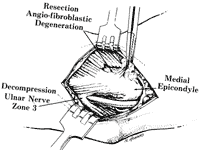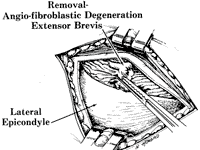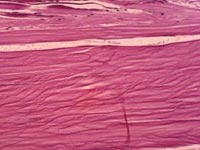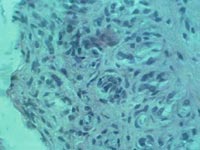Proper diagnosis, treatment of tennis elbow often misunderstood
Robert P. Nirschl, MD, talks about fundamentals of treatment and preferred operative procedures in an interview conducted by Douglas W. Jackson, MD.
|
|
Robert P. Nirschl, MD Associate Clinical Professor of Orthopedic Surgery at Georgetown University, Nirschl Orthopedic and Sports Medicine Clinic, Washington, D.C. |
Douglas W. Jackson, MD: What is the underlying pathology in tennis elbow?
Robert P. Nirschl, MD: A major misunderstanding still prevails in a significant segment of the medical community and is exemplified by the continued use of the terms epicondylitis and tendinitis. First and foremost it is a tendon problem. The primary histopathology of both medial and lateral tennis elbow is not in the epicondyle, and inflammatory cells are not present in the tendon. My observation of all tendon overuse and failed healing (including the rotator cuff, patellar tendon, Achilles tendon, and plantar fascia as well as the elbow) is a degenerative process.
The histology (which we coined angio-fibroblastic hyperplasia in 1979 and was incorporated in Paddu’s Term Tendinosis re: The Achilles in l982) includes dysfunctional vascular and fibroblastic elements with total disorganization of collagen. Lateral tennis elbow is located in the extensor carpi-radialis brevis (ERCB) and extensor digitorum communis (EDC) tendons; medial tennis elbow is primarily in the flexor carpi radialis (FCR) and pronator teres (PT); and posterior is in the triceps. Ulnar nerve dysfunction is a common companion to medial tennis elbow.
Although there are no inflammatory cells in the histology, it is presumed that a chemical inflammatory response (perhaps cytokines and prostaglandins) and an angina type tissue response in association with the devitalized tendinosis are the pain producers.
Jackson: What are the key features of nonoperative treatment?
Nirschl: The fundamentals of nonoperative treatment are also often misunderstood when comfort is confused with cure. The biological goals of cure are revitalization of the degenerated tendinosis tissue by neovascularization and fibroblastic proliferation with collagen production. The curative overview also includes the restoration of strength, endurance, and flexibility of the shoulder and entire upper extremity as well as the arm and forearm. Rehabilitative exercise is the key component in accomplishing these curative goals.
Conversely, pain control by absolute rest and anti-inflammatory medication including cortisone injections has no direct curative effect. Pain control, however, is important in the context of eliminating this major inhibitor to effective rehabilitative exercise. Our standard modality for pain control is high voltage electrical stimulation as well as heat and cold.
A recently published prospective control study at our institution has also demonstrated increased effectiveness with iontophoresis. Recent alternative treatment methods including manufacture-driven, expensive extra-corporeal shock waves and autogenous blood injections have been advanced as curative. Although temporary pain control has been reported by these techniques in some patients, there is no science to support the contention of revitalization of tendinosis tissue.
|
|
|
|
COURTESY OF ROBERT P. NIRSCHL |
|
Jackson: What is the role of bracing?
Nirschl: The curative aspects of nonoperative treatment balance the concepts of elbow and shoulder improvement with the control of injury producing overuse forces. Key approaches to controlling overuse include activity techniques and equipment selections, as well as modification of the frequency, intensity and duration of the activity. In 1972, I introduced the bracing term “counter force” to reflect a form of dynamic functional support.
The counter force concept in tennis elbow bracing is to encourage balanced muscle action and disseminate focused forearm overuse pressures away from the ECRB and EDC in lateral tennis elbow and PT and FCR in medial tennis elbow. Brace design plays an important role in effectiveness, and my observation supports the choice of a dual strap curvilinear wide brace for accurate fit and tension control about the conical shape of the proximal forearm.
Other aspects of force load control such as workplace ergonomics and sports control all play a significant role. The goal of high-demand performance activity (eg, sports, performing arts and occupational) is not good musculoskeletal health but performance in an abusive environment. Diminution of violence, therefore, has high priority.
|
|
|
Jackson: When is surgery an option?
Nirschl: The indications for surgery are failure of a quality rehabilitation exercise program and an unacceptable quality of life as defined by the patient. The usual symptoms supporting a surgical solution include pain with activities of daily living and rest pain. It should be emphasized again that comfort physical therapy, anti-inflammatories and rest do not constitute a quality program.
In the usual general orthopedic practice, less than 5% of patients would be anticipated to require surgery. In our referral practice, 30% come to surgical intervention.
Jackson: What is your preferred surgical approach?
Nirschl: My preferred approach is by mini-open technique. The essential concept of surgery is to clearly identify and resect the pain producing tendinosis tissue, which may be done easily by proper placement of a small incision. Let me emphasize this is not a release concept and not an epicondylectomy, both of which harm normal tissue and often fail to address the true patho-anatomy.
In the lateral elbow it is critical to identify the ECRB, which is located under the extensor carpi-radialis longus (ECRL). In the medial elbow the FCR and PT are the key tissues with a high companion incidence of neuropraxia of the ulnar nerve via compression in zone 3 of the medial epicondylar groove. Often bicondylar tendinosis exists (eg, lateral and medial) and both are addressed at the same surgical setting.
Jackson: Do you see a role for arthroscopy in tennis elbow?
Nirschl: As noted, the key issue is identification of the tendinosis tissue, which is extraarticular. Only 5% of lateral tennis elbow patients in my experience have an intraarticular issue and this is easily handled by a small arthrotomy expansion of our mini-incision. Arthroscopy is an intraarticular approach, which must then proceed to an extraarticular resection. Interestingly, a sports medicine fellow at one of the institutions advancing arthroscopy approached me recently and wondered if the true tendinosis pathoanatomy can be identified by our mini-open technique, as he didn’t feel it was identifiable by the arthroscopic approach he observed during his fellowship.
Since our mini-open technique is so highly successful (97%) and the postoperative morbidity essentially matches the arthroscopic approaches, I see no valid reason to subject patients to a procedure that violates the joint, has higher neurovascular risks, takes more time, is more costly, and may be less successful. In addition, in bicondylar situations (medial and lateral), especially with ulnar nerve symptoms, the arthroscopic approach is not applicable.
|
Jackson: What are the causes of failed surgery?
Nirschl: The most common reason for unsuccessful surgery by far is failure to adequately address the patho-anatomy. This invariably occurs when the index operation is the old concept, namely a release of the entire extensor or flexor origin from the epicondyle. On the lateral side, the pain-producing ECRB tendinosis is left behind and iatrogenic harm occurs to normal tissue, including, on occasion, the collateral ligament. On the medial side, the issue is the same regarding tendinosis; failure to address the ulnar nerve is often a contributing problem. Fortunately, both medial and lateral salvage surgery is often quite successful if the proper surgical principles are adhered to.
For more information:
- Groppel J, Nirschl RP: A mechanical and electromyographical analysis of various joint counterforce braces on the tennis players. Am J Sports Med. 1998;14:195-200.
- Nirschl RP: Elbow tendinosis/tennis elbow. Clin Sports Med. 1992;11:851-870.
- Olliviere CO, Nirschl RP, Pettrone FA. Resection and repair for medial tennis elbow. Am J Sports Med. 1995;23:214-221.
- Nirschl RP, Sobel J. Arm Care, Medical Sports Publishing, 1996. Arlington, VA.
- Kraushaar B, Nirschl R. Current concepts review: tendinosis of the elbow (tennis elbow). J Bone Joint Surg Am. 1999;81-A:259-278.
- Nirschl RP, Rodin DM, Ochiai DH, Maartmann-Moe C. Iontophoretic administration of dexamethasone sodium phosphate for acute epicondylitis: a randomized, double blinded, placebo-controlled study. Am J Sports Med. 2003;31:189-195.
- Nirschl RP, Ashman, ES: Elbow tendinopathy: tennis elbow. Clin Sports Med. 2003;22:613-836.

![Robert P. Nirschl, MD [photo]](/~/media/images/news/print/orthopedics-today/2004/04_april/nirschl_70_90_1799.jpg)



